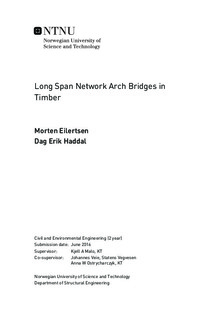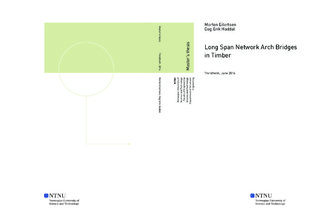| dc.description.abstract | For years, the reduction in greenhouse gas emissions have been a global goal, and in the recent years this has led to an increased focus on emissions from the construction industry as well. With timber being an environmental-friendly building material, the focus on the environment has led to the construction of a number of minor timber bridges in Norway the past years.
This master thesis looks at the possibility of constructing long span network arch bridges in glue-laminated timber. The thesis presents two structural alternatives and compare these with a network arch bridge in steel and concrete, Driva Bridge. The primary focus has been on the structures stability, cost and feasibility. The bridge span is 111 meters for all three bridges.
Alternative 1: A network arch bridge without wind bracing between arches. Instead, the bridge has hangers with an out-of-plane angle relative to the arch to create sideways stability. One of the reasons for this is to avoid connections on the side of the arches, which are more vulnerable for weather damage. The arches have a massive glulam cross-section with moment resistant splice joints. The arches cross-section is 1600x850 mm2. The hangers are connected to the transverse beams, thus having an equidistant distribution on the lower chord. The transverse steel beams support the stress laminated timber deck. The bridge has no ties, and is therefore relying on the foundation to absorb the horizontal forces at the support.
Alternative 2: A network arch bridge with the same design as Driva Bridge. The bridge has glue-laminated K-shaped wind bracings for sideways stability. The arches have a massive glulam cross-section varying from 1100x1100 mm2 to 850x850 mm2. The bridge deck is the same as for alternative 1. The transverse beams and the hangers are connected to box-profile steel ties. The hangers have an equidistant distribution on the arch.
Structural analyses has been carried out on numerical models in the FEM-software Abaqus CAE, and Focus Konstruksjoner. Design checks have been carried out after relevant Eurocodes and design manuals.
Rough cost estimates have been made on the bridge alternatives to find out if they are cost competetive with Driva Bridge. The cost data used are based on previous projects, actual costs on Driva Bridge and budget prices provided from manufacturers. | |

